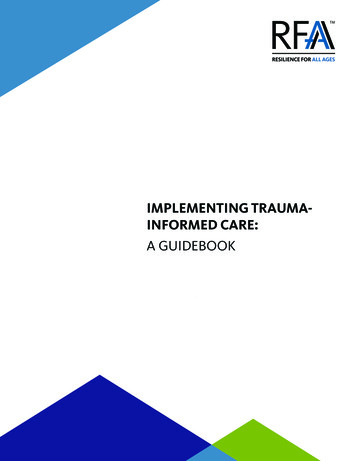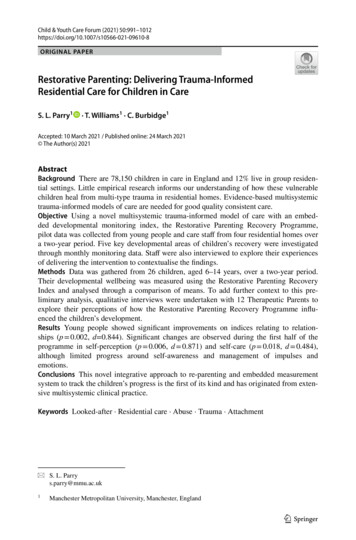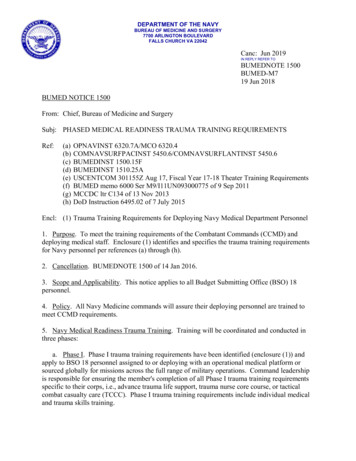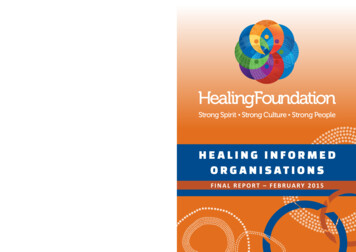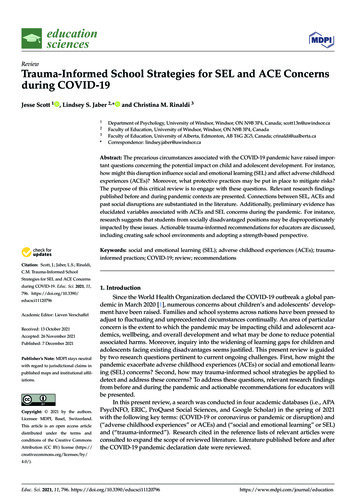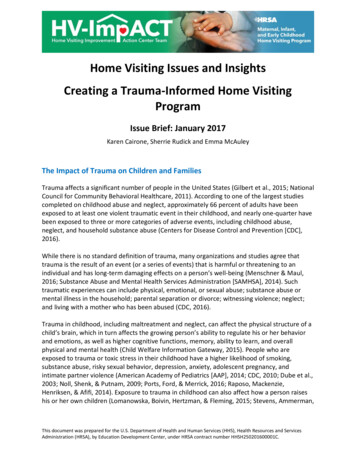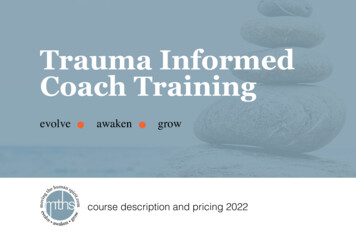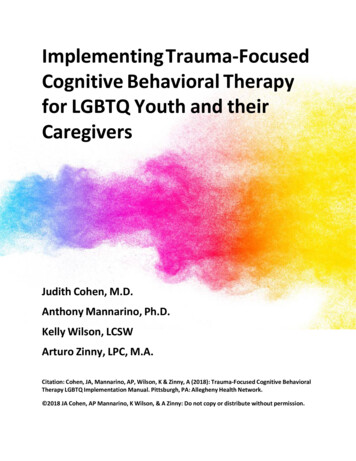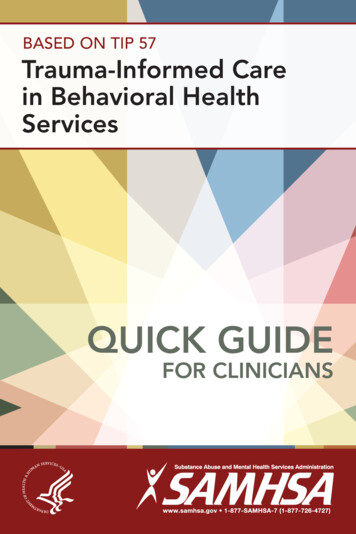
Transcription
BASED oN TIP 57Trauma-Informed Carein Behavioral HealthServicesQUICK GUIDEFOR ClInICIanS
ContentsWhy a Quick Guide? . 2What Is a TIP? . 3Introduction. 5Trauma and Substance Use Disorders . 9Trauma and Mental Disorders. 10Trauma-Informed Treatment Principles . 11Types of Trauma: Natural orHuman-Caused. 22Characteristics of Trauma . 23Common Experiences of and Responsesto Trauma . 30Screening and Assessment . 42Trauma-Informed Treatment objectivesand Strategies . 48Making Referrals From Trauma-Informed toTrauma-Specific Services. 65
Based on TIP 57Trauma-Informed Carein Behavioral HealthServicesQUICK GUIDEFOR CLINICIANSThis Quick Guide is based entirely on informationcontained in TIP 57, published in 2014. No additionalresearch has been conducted to update this topic sincepublication of TIP 57.
TIP 57: Quick Guide for CliniciansWhy a Quick Guide?This Quick Guide accompanies the serviceimprovement guidelines set forth in Trauma-InformedCare in Behavioral Health Services, Number 57 inthe Treatment Improvement Protocol (TIP) series.It summarizes the how-to information in TIP 57pertinent to behavioral health counselors and clinicians,focusing on principles, tools, and approaches inproviding trauma-informed care.Users of this Quick Guide are invited to consult theprimary source, TIP 57, for more information onspecific strategies that promote trauma-informed care.To order a copy or access the TIP online, see the insideback cover of this Quick Guide.DISCLAIMER2The opinions expressed herein are the views of theconsensus panel members and do not necessarilyreflect the official position of the Substance Abuse andMental Health Services Administration (SAMHSA)or the U.S. Department of Health and Human Services(HHS). No official support of or endorsement bySAMHSA or HHS for these opinions or for theinstruments or resources described are intended orshould be inferred. The guidelines presented should notbe considered substitutes for individualized client careand treatment decisions.
What Is a TIP?What Is a TIP?The TIP series provides professionals in behavioralhealth and related fields with consensus-based, fieldreviewed guidelines on behavioral health topics ofvital current interest. The TIP series is published bySAMHSA and has been in production since 1991.TIP 57, Trauma-Informed Care in Behavioral HealthServices: Lays the groundwork for the implementation andprovision of trauma-informed services. Describes trauma-informed treatment principles. Provides an overview of traumatic experiences,including types of trauma and traumacharacteristics. Addresses the socioecological and cultural factorsthat influence the impact of trauma. Focuses on the impact of trauma, trauma-relatedstress reactions and associated symptoms, andcommon mental health and substance use disordersassociated with trauma. Introduces screening and assessment as they relateto trauma. Covers clinical issues that behavioral healthprofessionals may need to address when treatingclients who have histories of trauma.3
TIP 57: Quick Guide for Clinicians Presents information on specific treatment modelsfor trauma, distinguishing integrated models fromthose that treat trauma alone.Other TIPs of interest to readers include: TIP 25: Substance Abuse Treatment and DomesticViolence TIP 36: Substance Abuse Treatment for Persons WithChild Abuse and Neglect Issues TIP 48: Managing Depressive Symptoms in SubstanceAbuse Clients During Early Recovery TIP 51: Substance Abuse Treatment: Addressing theSpecific Needs of Women TIP 59: Improving Cultural CompetenceNote: You may download TIPs and other related products for freethrough the SAMHSA Store at http://store.samhsa.gov.4
IntroductionIntroductionGuidelines for ReadersMany individuals experience trauma during theirlifetimes. Although many people exposed to traumademonstrate few or no lingering symptoms, those whohave experienced repeated, chronic, or multiple traumasare more likely to exhibit pronounced symptomsand to experience consequences, including substanceabuse, mental illness, and physical health problems.Subsequently, trauma can significantly affect how anindividual engages in major life areas as well as intreatment.TIP 57 provides evidence-based and best practiceinformation for behavioral health service providers andadministrators who want to work more effectively withpeople who have been exposed to acute and chronictraumas and/or are at risk of developing traumaticstress reactions. TIP 57 addresses trauma-relatedprevention, intervention, and treatment issues andstrategies across behavioral health settings.TerminologyRetraumatization. This term not only refers to theeffect of being exposed to multiple traumatic events,but also implies the process of reexperiencing traumaticstress as a result of a current situation that mirrors orreplicates in some way the prior traumatic experiences5
TIP 57: Quick Guide for Clinicians(e.g., specific smells or other sensory input; interactionswith others; responses to one’s surroundings orinterpersonal context, such as feeling emotionally orphysically trapped).Secondary trauma. This term describes trauma-relatedstress reactions and symptoms resulting from exposureto another individual’s traumatic experiences, ratherthan from exposure directly to a traumatic event.Secondary trauma can occur among behavioral healthservice providers across all settings and among allprofessionals who provide services to people who haveexperienced trauma (e.g., healthcare providers, peercounselors, first responders, clergy, intake workers).Substance abuse. This term refers to both substanceabuse and substance dependence. This term waschosen partly because behavioral health professionalscommonly use “ substance abuse” to describe anyexcessive use of addictive substances. In this QuickGuide, the term refers to the use of alcohol as wellas other substances of abuse. Attend to the contextin which the term occurs to determine what possiblerange of meanings it covers; in most cases, it willrefer to all varieties of substance-related disordersas found in the Diagnostic and Statistical Manual of6
IntroductionMental Disorders, Fifth Edition (American PsychiatricAssociation, 20131).Trauma. “Trauma results from an event, series ofevents, or set of circumstances that is experienced byan individual as physically or emotionally harmfulor life threatening and that has lasting adverseeffects on the individual’s functioning and mental,physical, social, emotional, or spiritual well-being”(SAMHSA, 2014, p. 72). Although many individualsreport a single specific traumatic event, others,especially those seeking mental health or substanceabuse treatment services, have been exposed tomultiple or chronic traumatic events.Trauma-informed care (TIC). A trauma-informedapproach to the delivery of behavioral health servicesincludes an understanding of trauma and an awarenessof the impact it can have across settings, services,and populations. It involves viewing trauma throughan ecological and cultural lens and recognizing thatcontext plays a significant role in how individualsperceive and process traumatic events, whether acute1American Psychiatric Association. (2013a). Diagnostic and statisticalmanual of mental disorders. (5th ed.). Arlington, VA: AmericanPsychiatric Association.2Substance Abuse and Mental Health Services Administration. (2014).SAMHSA’s concept of trauma and guidance for a trauma-informed approach.HHS Publication No. (SMA) 14-4884. Rockville, MD: SubstanceAbuse and Mental Health Services Administration.7
TIP 57: Quick Guide for Cliniciansor chronic. TIC involves vigilance in anticipating andavoiding institutional processes and individual practicesthat are likely to retraumatize individuals who alreadyhave histories of trauma, and it upholds the importanceof consumer participation in the development, delivery,and evaluation of services.Trauma survivor. This phrase can refer to anyonewho has experienced trauma or had a traumatic stressreaction. Given that the use of language and wordscan set the tone for recovery or contribute to furtherretraumatization, this Quick Guide puts forth amessage of hope by avoiding the term “victim” andinstead using the term “survivor” when appropriate.Before You BeginIndividuals who have experienced trauma are at anelevated risk for substance use disorders, includingabuse and dependence, mental disorders (e.g.,depression and anxiety disorders, impairment inrelational/ social and other major life areas, otherdistressing symptoms), and physical disorders andconditions, such as sleep disorders. TIP 57 endorsesa trauma-informed model of care, which holds thatbehavioral health practitioners and organizationsneed to recognize the prevalence and pervasive impactof trauma on the lives of the people they serve anddevelop trauma-responsive services.8
Trauma and Substance Use DisordersTrauma and Substance UseDisorders Many people who have substance use disorders haveexperienced trauma as children or adults. Substance abuse predisposes people to higherrates of traumas, such as dangerous situations andaccidents, while under the influence and as a resultof the lifestyle associated with substance abuse. People who abuse substances and have experiencedtrauma have worse treatment outcomes than thosewithout histories of trauma. More than half of individuals who seek substanceabuse treatment report one or more lifetimetraumas, and a significant number of clients ininpatient treatment also have subclinical traumaticstress symptoms or posttraumatic stress disorder.9
TIP 57: Quick Guide for CliniciansTrauma and Mental Disorders Individuals in treatment for severe mental 10disorders are more likely to have histories oftrauma, including childhood physical and sexualabuse, serious accidents, homelessness, involuntarypsychiatric hospitalizations, drug overdoses,interpersonal violence, and other forms of violence.Many clients with severe mental disorders also meetcriteria for posttraumatic stress disorder (PTSD).Individuals with serious mental illness who havehistories of trauma often present with otherpsychological symptoms or disorders commonlyassociated with trauma, including anxiety, mooddisorders (e.g., major depression, dysthymia, bipolardisorders), and substance use disorders.Traumatic stress increases the risk for mentalillness, and findings suggest that traumatic stressincreases the symptom severity of mental illness.Research suggests that trauma often precedes thedevelopment of mental disorders.Mental illness increases the risk of experiencingtrauma, and trauma increases the risk of developingpsychological symptoms and mental disorders.
Trauma-Informed Treatment PrinciplesTrauma-Informed TreatmentPrinciples1. Promote Trauma Awareness andUnderstandingAs a counselor, you must recognize the prevalence oftrauma and its possible role in your clients’ emotional,behavioral, cognitive, spiritual, and/or physicaldevelopment and presentation. By being vigilant aboutthe prevalence and potential consequences of traumaticevents among clients, you can then tailor your style,approach, and strategies from the outset to plan forand be responsive to their specific needs. Although notevery client has a history of trauma, it is important toknow that those who have substance use and mentaldisorders are more likely to have experienced trauma.2. Recognize That Trauma-Related Symptomsand Behaviors Originate From Adapting toTraumatic ExperiencesAppreciating clients’ perception of their presentingproblems and viewing their responses to the impactof trauma as adaptive—even when you believe thattheir methods of dealing with trauma have beendetrimental—are equally important elements of TIC.Once you begin to view your clients’ behaviors asadaptive, your identification and classification of theirpresenting symptoms and behaviors can shift froma “pathology” mindset (i.e., defining clients strictly11
TIP 57: Quick Guide for Cliniciansthrough a diagnostic lens, implying that somethingis wrong with them) to one of resilience—a mindsetthat views clients’ presenting difficulties, behaviors,and emotions as responses to surviving trauma. Youwill come to view traumatic stress reactions as normalreactions to abnormal situations.3. View Trauma in the Context of Individuals’EnvironmentsTo understand trauma adequately, you must considerthe contexts in which it occurred. Individual attributes,developmental factors (including protective andrisk factors), life history, type of trauma, specificcharacteristics of the trauma, amount and length oftrauma exposure, cultural meaning of traumatic events,number of losses associated with the trauma, availableresources (internal and external, such as coping skills andfamily support), and community reactions are a few ofthe determinants that influence a person’s responses totrauma across time. Trauma cannot be viewed narrowly;instead, it needs to be seen through a broader lens.4. Minimize the Risk of Retraumatization orReplicating Prior Trauma DynamicsA trauma-informed approach begins with takingpractical steps to reexamine treatment strategies,program procedures, and organizational polices thatcould solicit distress or mirror common characteristics12
Trauma-Informed Treatment Principlesof traumatic experiences (e.g., loss of control, beingtrapped, feeling disempowered).Potential Treatment Issues That Can CauseRetraumatization Using seclusion, restraint, or “time-out” practicesthat isolate individualsMislabeling client symptoms as personality orother mental disorders, rather than as traumaticstress reactionsBeing overly authoritative when interacting withclientsGiving treatment assignments that could humiliateclients (e.g., asking a client to wear a sign in groupthat reflects one of his or her treatment issues, evenif the assignment centers on positive attributes ofthe client)Using a confrontational approachPresenting treatment as conditional on conformityto the counselor’s beliefs and definitions of issuesChallenging or discounting reports of abuse orother traumatic eventsAllowing the abusive behavior of one client towardanother to continue without interventionLabeling client behavior/feelings as pathologicalBeing unaware that the client’s traumatic historysignificantly affects his or her life13
TIP 57: Quick Guide for CliniciansClients’ experiences are unique to the specific traumasthey have faced and the circumstances they experiencedbefore, during, and after trauma, so remember thateven seemingly safe and standard treatment policiesand procedures may feel quite the contrary for clientsif an element of those processes is reminiscent of theirexperience of trauma in some way. Trauma-informedproviders anticipate and respond to practices thatclients may potentially perceive as retraumatizing.5. Create a Safe EnvironmentAs a counselor, you need to be responsive in adaptingthe environment to establish and support clients’sense of physical and emotional safety. Beyondanticipating that various environmental stimuliwithin a program may generate strong emotionsand reactions in trauma survivors and implementingstrategies to help clients cope with triggers that evoketheir experiences with trauma, other key elements inestablishing a safe environment include consistencyin client interactions and treatment processes, followthrough with what has been agreed on in sessions ormeetings, and dependability. Creating safety is abouthow consistently and forthrightly you handle situationswith clients when circumstances provoke feelings ofbeing vulnerable or unsafe. Honest and compassionatecommunication that conveys a sense of handling thesituation together generates safety.14
Trauma-Informed Treatment Principles6. Identify Recovery From Trauma as a PrimaryGoalIt is important that you help clients bridge the gapbetween their mental health and substance-relatedissues and the traumatic experiences they may havehad. All too often, trauma occurs before substance useand mental disorders develop; then, such disorders andtheir associated symptoms and consequences createopportunities for additional traumatic events to occur.If individuals engage in mental health and substanceabuse treatment without addressing the role that traumahas played in their lives, they are less likely to experiencerecovery in the long run. For example, a person witha history of trauma is more likely to have anxiety anddepressive symptoms, use substances to self-medicate,and/or relapse after exposure to trauma-related cues.7. Support Control, Choice, and AutonomyGaining a sense of control and empowerment, alongwith an understanding of traumatic stress reactions,is pivotal to recovery. By creating opportunities forempowerment, you may help reinforce clients’ senseof competence, which is often eroded by trauma andprolonged traumatic stress reactions. Keep in mindthat treatment strategies and procedures that prioritizeclient choice and control need not focus solely on majorlife decisions or treatment planning. You can apply suchapproaches to common tasks and everyday interactionsbetween staff and consumers.15
TIP 57: Quick Guide for Clinicians8. Create Collaborative Relationships andParticipation OpportunitiesIndividuals affected by trauma present an array ofreactions, various levels of trauma awareness, anddifferent degrees of urgency in their need to addresstrauma. By taking the time to understand the waysin which each client has perceived, adjusted to, andresponded to traumatic experiences, providers aremore likely to project the message that clients possessvaluable personal expertise and knowledge about theirown presenting problems. This shifts the viewpointfrom, “We, the providers, know best,” to the morecollaborative, “Together, we can find solutions.”To achieve trauma-informed competence in anorganization or across systems, clients need to playan active role. This starts with providing programfeedback. It also means giving clients/consumers thechance to obtain state training and certification, as wellas employment in behavioral health settings as peerspecialists. Programs that incorporate peer supportservices reinforce a powerful message: that provider–consumer partnership is important, and that consumersare valuable.9. Familiarize Clients With Trauma-InformedServicesFamiliarizing clients with trauma-informed servicesextends beyond explaining program services or16
Trauma-Informed Treatment Principlestreatment processes; it involves explaining the valueand types of trauma-related questions that may beasked during an intake process, educating clients abouttrauma to help normalize traumatic stress reactions,and frequently discussing trauma-specific interventionsand other available services (including explanations oftreatment methodologies and of the rationale behindspecific interventions).10. Conduct Universal Routine TraumaScreeningAlthough most providers know that individuals canbe affected by trauma, universal screening provides areminder to be watchful for past traumatic experiencesand their potential influence on clients’ interactions andengagement with services across the continuum of care.Screening should guide treatment planning; it alertsstaff to potential issues and serves as a valuable toolto increase clients’ awareness of the possible impact oftrauma and the importance of addressing related issuesduring treatment. Nonetheless, screenings are only asuseful as the processes established to address positivescreens (which occur when clients respond to screeningquestions in a way that signifies possible trauma-relatedsymptoms or histories).11. View Trauma Through a Sociocultural LensTo understand how a traumatic event affects anindividual, family, or community, you must first17
TIP 57: Quick Guide for Cliniciansunderstand life experiences and cultural backgroundas key contextual elements for that trauma. Manyfactors shape traumatic experiences and individualand community responses to them; one of the mostsignificant factors is culture. Culture influences theinterpretation of traumatic events, individual beliefsabout personal responsibility for the trauma andsubsequent responses, and the meaning and acceptabilityof symptoms, support, and help-seeking behaviors.12. Use a Strengths-Focused Perspective ToPromote ResilienceFostering individual strengths is a key step inprevention when working with people who have beenexposed to trauma. Knowledge of a client’s strengthscan help you understand, redefine, and reframe theclient’s presenting problems and challenges. Byfocusing and building on an individual’s strengths,counselors and other behavioral health professionalscan shift the focus from, “What is wrong with you?” to,“What has worked for you?”1813. Foster Trauma-Resistant SkillsBuilding trauma-resistant skills begins withnormalizing the symptoms of traumatic stress andhelping clients who have experienced trauma connectthe dots between current problems and past traumawhen appropriate. Developing trauma resistancefocuses on developing self-care skills, coping strategies,supportive networks, and a sense of competence.
Trauma-Informed Treatment PrinciplesUsing Strengths-Oriented QuestionsHere are a few potential strengths-oriented questions: What behaviors have helped you survive duringand after your traumatic experiences? What are some of the creative ways that you dealwith painful feelings? If we were to ask someone in your life, who knewyour history and experience with trauma, to nametwo positive characteristics that help you survive,what would they be? What coping tools have you learned from your(fill in: cultural history, spiritual practices,athletic pursuits, etc.)?14. Show Organizational and AdministrativeCommitment to TICBecoming a trauma-informed organization requiresadministrative guidance and support. Agencies needto embrace specific strategies across each level of theorganization to create trauma-informed services; thisbegins with staff education on the impact of traumaamong clients. For more information on implementingTIC in organizations, see Part 2, Chapter 1 of TIP 57.15. Develop Strategies To Address SecondaryTrauma and Promote Self-CareSecondary trauma is a normal occupational hazardfor mental health and substance abuse professionals,19
TIP 57: Quick Guide for Cliniciansparticularly those who serve populations that arelikely to include survivors of trauma. The demands ofproviding care to trauma survivors cannot be ignored.Symptoms of secondary trauma may include physicalor psychological reactions to traumatic memories thatclients have shared; avoidance behaviors during clientinteractions or when recalling emotional content insupervision; numbness, limited emotional expression,or diminished affect; somatic complaints; heightenedarousal, including insomnia; negative thinking ordepressed mood; and detachment from family, friends,and others. Symptoms may or may not meet diagnosticthresholds for acute stress, posttraumatic stress, oranxiety or mood disorders.16. Provide Hope—Recovery Is PossibleProviding hope involves projecting an attitude thatrecovery is possible. This attitude also involves viewingclients as competent to make changes that will allowthem to deal with trauma-related challenges, providingopportunities for them to practice dealing with difficultsituations, and normalizing discomfort or difficultemotions and framing these as manageable rather thandangerous. If you convey this attitude consistentlyto your clients, they will begin to understand thatdiscomfort is not a signal to avoid, but a sign toengage—and that behavioral, cognitive, and emotionalresponses to cues associated with previous traumas area normal part of the recovery process.20
Trauma-Informed Treatment PrinciplesDecreasing the Risk of Secondary Traumaand Promoting Self-Care Among Counselors Peer support. Maintaining adequate social supportwill help prevent isolation and depression.Supervision and consultation. Seekingprofessional support will enable you to understandyour own responses to clients and to work withthem more effectively.Training. Ongoing professional training canimprove your belief in your abilities to assist clientsin their recoveries.Personal therapy. Obtaining treatment can helpyou manage specific problems and enable you toprovide better treatment to your clients.Maintaining balance. A healthy, balanced lifestylecan make you more resilient in managing anydifficult circumstances you may face.Setting clear limits and boundaries with clients.Clearly separating your personal and work lifeallows time to rejuvenate from stresses inherent inbeing a professional caregiver.21
TIP 57: Quick Guide for CliniciansTypes of Trauma: Natural orHuman-CausedNatural traumatic experiences can directly affect asmall number of people, such as a tree falling on a carduring a rainstorm, or many people and communities,as with a hurricane. Natural events, often referred toas “acts of God,” are typically unavoidable. Humancaused traumas are caused by human failure (e.g.,technological catastrophes, accidents, malevolence) orby human design (e.g., war).Human-caused traumas are fundamentally differentfrom natural disasters. They are either intentional,such as a convenience store robbery at gunpoint,or unintentional, such as a bridge collapse dueto structural deterioration. The reactions to thesetraumas often depend on the intentionality of thetrauma. Survivors of an unintentionally humancaused traumatic event may feel angry and frustratedbecause of the lack of protection or care offered by theresponsible party or government, particularly if therehas been a perceived oversight. After intentionallyhuman-caused acts, survivors often struggle tounderstand the motives for performing the act,the calculated or random nature of the act, and thepsychological makeup of the perpetrator(s).22
Characteristics of TraumaCharacteristics of TraumaObjective characteristics are the tangible or factualelements of a traumatic event; subjective characteristicsinclude internal processes, such as determining thepersonal meaning of the trauma.Objective CharacteristicsWas it a single, repeated, or sustained trauma?Trauma can involve a single event, numerous orrepeated events, or sustained/chronic experiences. Asingle trauma is limited to a single point in time. Aseries of traumas happening to the same person overtime is known as repeated trauma. This can includerepeated sexual or physical assaults, exposure tofrequent injuries of others, or seemingly unrelatedtraumas. Military personnel, journalists covering storiesof mass tragedies or prolonged conflicts, and firstresponders who handle hundreds of cases each yeartypify survivors of repeated trauma. Repetitive exposureto traumas can also have a cumulative effect over anindividual’s lifetime. Sustained trauma experiences tendto wear down resilience and the ability to adapt. Someexamples include children who endure ongoing sexualabuse, physical neglect, or emotional abuse; individualswho are in violent relationships; and people who livein chronic poverty. Individuals in chronically stressful,traumatizing environments are particularly susceptible23
TIP 57: Quick Guide for Cliniciansto traumatic stress reactions, substance use, and mentaldisorders.Was there enough time to process theexperience?A particularly severe pattern of ongoing trauma,sometimes referred to as “cascading trauma,” occurswhen multiple traumas happen in a pattern that doesnot allow an individual to heal from one traumaticevent before another occurs. In other cases, thereis ample time to process an event, but processing islimited due to a lack of supportive relationships orenvironments. This can lead to greater vulnerability totraumas that occur further down the road.How many losses has the trauma caused?Trauma itself can create significant distress, but often,the losses associated with a trauma have more farreaching effects.Was the trauma expected or unexpected?Being unprepared, unaware, and vulnerable oftenincreases the risk of psychological injury, but theseare common ingredients of most traumas, given thatmost traumatic events do occur without warning(e.g., car crashes, terrorist attacks, sexual assaults).Sometimes, a trauma is anticipated but has unexpectedor unanticipated consequences, as in the case ofHurricane Katrina. However, most individuals attempt24
Characteristics of Traumato gain some control over the tragedy by replayingthe moments leading up to the event and processinghow they could have anticipated it. Some individualsperseverate on these thoughts for months or years afterthe event.Were the effects of the trauma on the person’slife isolated or pervasive?When individuals remain in the vicinity of the trauma,they are more likely to encounter greater challenges inrecovery (e.g. living in close proximity of a murderedfamily member). The traumatic event intertwineswith various aspects of the person’s daily activitiesand interactions, thus increasing the possibility ofbeing triggered by surrounding cues and experiencingsubsequent psychological distress.Who was responsible for the trauma and was theact intentional?If the severity of a trauma is judged solely by whetherthe act was intentional or not, events that reflect anintention to harm would be a primary indicator inpredicting subsequent difficulties among individualsexposed to this form of trauma.Trauma survivors can become heavily invested inassigning blame or finding out who wa
Substance abuse. his term refers to both substance abuse and substance dependence. his term was chosen partly because behavioral health professionals commonly use " substance abuse" to describe any excessive use of addictive substances. In this Quick Guide, the term refers to the use of alcohol as well as other substances of abuse.

